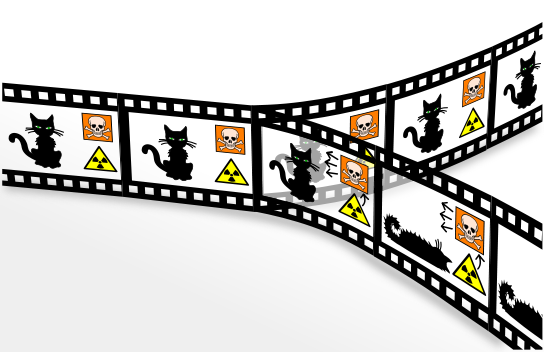

The problem we face here arises from the infamous “double slit experiment“. Many science enthusiasts will probably be familiar with this experiment (for those who are not, I have included a link at the bottom that explains this in more detail). As a quick summary, particles are fired through slits one at a time. As a result, an interference pattern emerges. This particular pattern is a wave characteristic. However, when physicists try to put a detector by the slits to see exactly which slit the particles went through, the pattern changes so there is no diffraction pattern. Instead, there are two solid lines (over time) of where each single electron went through one of the two slits as a particle. This raises some uncomfortable questions—particles or waves or…what?
The Two Interpretations:
The Copenhagen Interpretation: This interpretation is a little bit like quantum physics’ answer to the old Zen question: If a tree falls in the woods and no one is around to hear it, does it make a sound? The Copenhagen Interpretation is the most accepted view in physics, and is basically asserts that the measurement causes a set of probabilities to instantaneously assume only one value. Schrodinger utilized his famous thought experiment, Schrodinger’s Cat, to highlight the basic premise.
In this thought experiment, a cat is put in a box where poison is either released or not based on the random result of radioactive decay. If the decay occurs, then the poison is released and the cat dies. If it does not occur, then the poison is not released and the cat lives. While the box is closed, we do not know whether the radioactive decay has occurred or not. At this time, the cat is (literally) in a state of superposition, wherein it is simultaneously both dead and alive. After an hour, the box is opened and the cat’s state is measured (or observed). And it is this measurement (that act of opening the box to see if the cat is alive or dead) that causes the cat to have either lived or died (assume one value).
The problem with this interpretation is the whole idea of the “observer collapsing the wave function.” The question arises, what collapses the wave function? The measuring device? The human? The combined probability of you and the measuring device’s particles (a “paltry” 10^27 of them) collapsing it?
This is where physicists fall silent. We don’t know what causes the final value to form. The basic premise of this idea is that quantum mechanics does not give a description of an objective reality. Instead, quantum mechanics exclusively deals with probabilities of observing, or measuring, various aspects of energy quanta (which are entities that do not fit either the classical idea of particles or the classical idea of waves).
The Many Worlds Interpretation (or MWI): This interpretation is based solely on the Schrodinger equation, and it tells the story of the probability wave with unnerving accuracy. This formula describes how probability waves evolve over time and are always in effect. Schrodinger’s equation takes the particle’s initial probability wave shape as input, and it subsequently provides the wave’s shape at any future time. Thus, if the electron goes through both slits, both equations take effect. In other words, measuring a quantum object does not force it into one state or another. Rather, the measurement causes an actual split in the universe.
In fact, the various measurements could cause a split into multiple universes— one universe for each possible outcome of the measurement. The ideas asserts that, when a scientist in one universe finds that the object has been measured in wave form, scientist in the other universe measures the object as a particle (see, multiple universes). Conversely, the Copenhagen group would argue that only one of these universes exists because of a collapsing wave function.

These are not easy questions to answer, and here at FQTQ, we don’t have an answer either. As Aristotle once said, “It is the mark of an educated mind to be able to entertain a thought without accepting it.” Hopefully one day the physics community will be clever enough to settle this debate once and for all.
Read more about the double slit experiment here.